Reglas del camino: cómo los mejores juegos F2P garantizan que quienes más gastan no se queden atrapados en el tráfico
Imagina que estás en medio de un largo viaje por carretera con tu familia. El viaje comienza a un ritmo bastante rápido de 120 km/h. Todo va genial; llegas a tiempo, estás feliz y cada miembro de tu familia está agarrado a sus respectivos teléfonos.
Al cabo de unas horas, empiezas a notar que el tráfico en la carretera se vuelve denso. Como resultado, el ritmo de su automóvil comienza a disminuir. En realidad, sabes que esto no es una buena señal: años de conducción te han enseñado que te esperan horas de cola con pocas posibilidades de escapar, aunque estés rezando para estar equivocado.
De repente, alguien te interrumpe. Frenas de golpe justo a tiempo y, afortunadamente, evitas una colisión. Miras por el espejo retrovisor para asegurarte de que tus hijos están bien, y lo están. Sin embargo, ahora todos levantan la vista de sus teléfonos ante la densidad de automóviles en la carretera, y todos en el automóvil, como usted, temen lo que está por venir.
Ahora, si aún no lo habías adivinado, creo que tales eventos reflejan con precisión la experiencia que cada uno de nosotros atraviesa en algún momento con un juego gratuito de nivel medio a extremo. Al comienzo de este tipo de juegos, todos los jugadores saben que se quedarán atrapados en el tráfico, atrapados en las filas de autos y felices de sentarse en la rutina gratis en lugar de pagar la tarifa requerida para saltar adelante.
Depende de los desarrolladores decidir cómo sacarán de allí a los jugadores que pagan. ¿Deberían construir un carril para viajes compartidos? ¿Una carretera de peaje? ¿Instalar Google Maps con actualizaciones de tráfico? ¿Lanzar un helicóptero?
Carril de viaje compartido
Comencemos viendo un ejemplo de construcción en un carril para vehículos compartidos. Cuando se trata de juegos gratuitos, estos equivalen a una oferta de suscripción mensual, un modelo que se ha vuelto bastante popular en los últimos dos años.
En la práctica, le dan al jugador una suma global mediana de dinero en la compra inicial, seguida de una cantidad pequeña (pero significativa) cada día durante los siguientes 30 días. En última instancia, el monto total durante los 30 días es mucho más que una compra única por el mismo monto.
Rango de precios: Entre $2,99 y $9,99
En el siguiente ejemplo, Lineage 2: Revolution ofrece algunas suscripciones de Adena (oro) con cinco veces más moneda el primer día que la que recibe un jugador cada dos días del mes.
Si un jugador intentara comprar esta cantidad de Adena a la vez, tendría que pagar tres veces más, o tal vez incluso más.
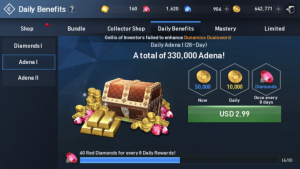
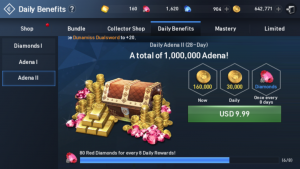
Realizamos una breve encuesta a los jugadores de nuestra comunidad Lineage 2 y descubrimos que 17 de 20 jugadores que gastaron dinero en este juego habían comprado estas suscripciones.
In reality, however, the daily rewards are very small. With one side quest that lasts five minutes, a player can earn 21,000 gold. Only five side quests can be performed daily, but still, the daily rewards are small. It’s not hard to understand how this $9.99 subscription only provides slight relief from the traffic.
It’s important that your subscription offers can scale as a player progresses to late game. In the examples above with Lineage, those offers quickly become irrelevant when a player reaches level 100 of 180. However, Lineage could easily offer higher priced subscriptions that are relevant to later levels.
Toll road
In truth, a toll road that diverts them away from the mass of traffic isn’t all too different from a carpool lane. It’s essentially the next tier in the same approach – a monthly subscription.
Price range: $19.99 to $29.99
It’s not often that I’ll see subscriptions for more than $29.99, because the audience that buys them are most likely budget players. Subscriptions certainly provide mild relief from the traffic – even driving 10 mph faster than the rest of the cars on the road, any driver knows you’re party to a few solid endorphins. However, it’s once again key to make sure you consider how these subscriptions scale to the latter stages of the game.
Google Maps
Has Google Maps ever offered you a shortcut, but in reality it felt like it took just as long to get to your destination as if you’d stuck to your original path?
It’s a feeling that sucks and makes every future trip feel like something of a risk. However, as the likes of Google upgrade their software, so such events are becoming rarer and rarer. For every bad turn, shortcuts cuts actually end up paying off, offering you a smarter route that cuts your journey time. It’s at this point that using platforms like Google Maps builds trust with the consumer, and this to me is exactly how Gachas feel.
Price range: $29.99 to $99.99
If I pull my wallet out and take the leap of faith to try my luck on a gacha, and the rewards make me feel like I could’ve just played a few more days to get the same rewards, then I’m very discouraged to try my luck again. Maybe your VIPs will try their luck a few more times, but are unlikely to keep trying if they don’t see a solid result? On the contrary, if players get a favorable result the first time, their first impression of spending will be positive. It’s a feeling that can go a long way.
Personally, I like it when I see games that have limited offers of guaranteed results – preferably, even their most expensive gachas offer favorable results. For example, there’s a rival to the ridiculously successful Clash Royale that has unexpectedly held my attention for far longer than I expected. Star Wars: Force Arena comes complete with gachas that boast some guaranteed results. In this case, I’m more likely to make a purchase because the guaranteed results take any random elements out of the equation.
In the image below, I can buy a package with certain characters having a much higher, guaranteed chance to drop. I love this type of offer because I’m guaranteed to save a lot of time.
The legendary drop rates in this game for free packs that come from winning battles are so low that I’ve never received any legendary items in the two months I’ve been playing. Thus, I know for a fact that making this purchase will put me way ahead of many competitors.
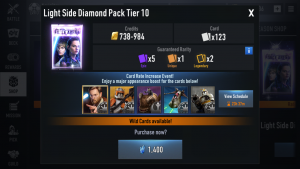
On the other hand, Clash Royale’s special offers aren’t guaranteed to drop the character types that match my deck. This makes the risk a lot higher. Some days, I might be feeling rich and want to take my chances on a gacha, but my conservative nature makes me lean towards the packages in Star Wars: Force Arena with major appearance boosts.
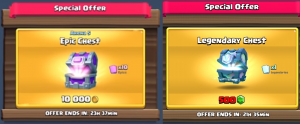
A very engaged, passionate, wealthy audience might go for full risk gachas like in Clash Royale, but the more trust you take out of the equation, the higher conversion rate you’ll have. Consider the great feeling you get when Google Maps says, “Save 25 minutes by this recommended route,” and it actually happens. That’s exactly what a successful gacha feels like.
With gachas, like subscriptions, it’s also important to consider their relevance in late game. Early to mid game players are likely to have a high chance of a good first impression, because they don’t need legendary drops to make significant progress. However, late game players can only progress with legendary drops. As a result, you might have a different format of gacha for them, and it may only appear to those certain higher level players.
Helicopter
Arguably, what every driver wants when ground to a halt in traffic is for someone to pick them up and fly them off at speed into the distance. There’s nothing quite as frustrating as moving a few inches a minute. Players want to fly.
Some developers, like Machine Zone (MZ), put the option to fly front and centre. MZ’s sales are exclusively in the form of bundles that offer an enormous amount of various currency items: speedups, resources, hero XP, VIP, alliance gifts, unique key upgrade items, etc. All of this is offered for a price – usually $99.99. These bundles offer so much, that they often give the player the experience of flying through the game.
In MZ’s monetization strategy, the only option is to fly, because traffic is at a dead stop. After only a few levels, each upgrade takes an enormous time. While level 10 of 25 buildings might only take a few hours, level 11s take half a day. With each new level unlocked, the wait time scales much higher and longer. Believe it or not, some timers even take a few years to complete.
Take a look at the length of speed ups offered in a package from the studio’s most recent game, Final Fantasy XV: A New Empire.
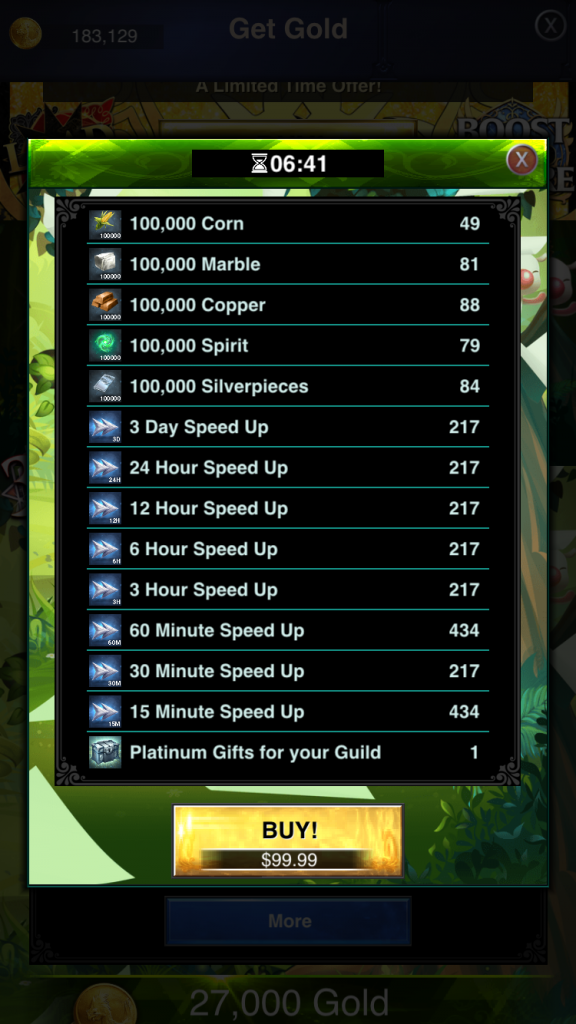
It’s an interesting approach, namely because it’s ‘all or nothing’. Players can’t make any progress using traditional free to play methods in Final Fantasy XV: A New Empire. Assuming equal skill level, it is impossible to compete with those who have spent a few hundred more dollars than you. Dipping back into our analogy, the price of flying ahead with a helicopter ride is high – at a minimum, purchases will be between $49.99 and $99.99.
Most of the time, packs in MZ games give guaranteed results. The Valentine’s Day sale below offers instant upgrades to level 30 for all buildings.
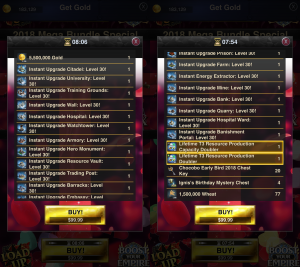
Occasionally, MZ will have sales with hundreds or thousands of gacha chests. When this happens, a VIP player will typically buy a few and let the rest of the population know if the chests have good drop rates or not. So, once again, first impressions are a big deal.
However, I do want to warn you about changing the drop rates after the initial purchase. We’ve seen MZ try to do this in various ways. Players always find out eventually, and it leaves a bad taste in their mouth.
Don’t run out of road!
We’ve covered all the different ways you can help players get out of traffic, but it’s also important to make sure you don’t run outof road, because then you’ll have no traffic left to monetize.
Different games take different approaches to this. For example, in Lineage 2, the first few expansions of the game offer limited additional content that can be quickly maxed with a few hundred dollars. Then, what’s left is a deep meta game of tediously limit breaking gear, rolling for the best stats you can, and experimenting with different builds for PVP – essentially, it’s a PVP-driven end game.
Counter to that is Final Fantasy XV: A New Empire, which never lets any player max the game. When a new feature is released, the first few levels will be attainable with a few hundred dollars; the next few levels can be acquired with a few thousand dollars, but the last few levels will be unattainable for even the largest VIPs.
When MZ is ready to release the next feature, it increases the currency in packs necessary to max the last few levels of the previous feature, at the same time as releasing the next feature.
Conclusion
En resumen, el trabajo de un desarrollador es asegurarse de que los jugadores puedan esquivar el tráfico como mejor les parezca. Si los jugadores quieren gastar dinero para salir de la rutina, el juego debería poder ofrecerles satisfacción inmediata y gratificación sostenida. El truco consiste en asegurarse de que sientan que salir del tráfico es algo que no podrían haber logrado de la misma manera sin gastar dinero; su inversión debe valer la pena y hay tres formas clave de lograrlo:
- Los artículos de alta conversión deben tener niveles
- Gachas debería garantizar caídas con el tiempo (mientras aumenta el costo)
- Las ventas dirigidas a los VIP deben hacer todo lo posible: asegúrese de ofrecer una gran variedad de contenido que permita a los VIP llegar a donde quieran, sin restricciones.
Siga las reglas de tránsito establecidas anteriormente y puede estar seguro de que su juego estará lleno de conductores felices y contentos.
Sobre el Autor
Chad Kihm es el director ejecutivo de App Scrolls, una empresa que ofrece consultoría en diseño de juegos, desarrollo y gestión de comunidades, así como servicios de marketing comunitario. App Scrolls actualmente administra comunidades para Game of War, Final Fantasy XV: A New Empire, Summoner's War y Lineage 2: Revolution.
Leave a Reply